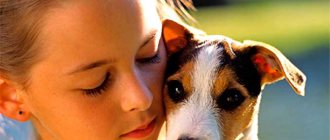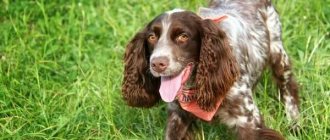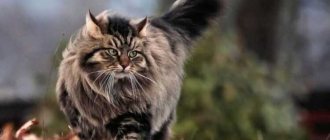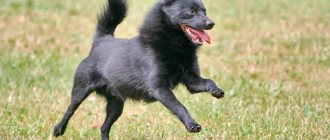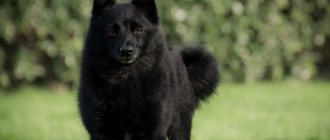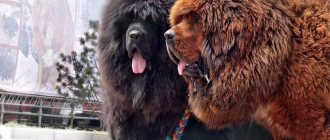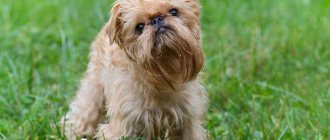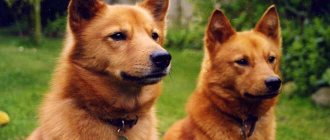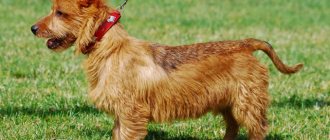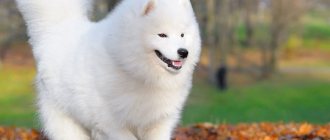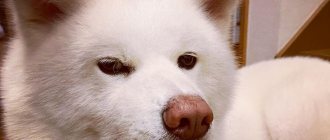Description of the Schipperke breed
Popularity 98th place among 263 dog breeds
Lifespan:
12-13 years old
Breed group:
Service
Height:
males: 29-35 cm, females: 26-30 cm
Country of origin:
Belgium
Average price:
50-70 thousand rubles
Weight:
males: 7-10 kg, females: 3-6 kg
Latest articles Cat health
Ataxia in cats: what is it, how does it manifest and is treated 01/23/2022 156 0 0
Cat health
Leukemia, or viral leukemia in cats 01/23/2022 145 0 0
Accompanying illnesses
Cheerful animals usually do not have health problems; they happily live up to 15 years.
Visits to the clinic are possible due to:
- Hypothyroidism;
- Allergies;
- Patella dislocation;
- Perthes disease.
The breed is characterized by one significant unpleasant disease - mucopolysaccharidosis, which, unfortunately, cannot be cured. It appears from the age of 2, the reason lies in a genetic mutation that is inherited.
The price of a Schipperke ranges from 30-70 thousand rubles; in order not to buy a sick baby, it needs to be tested. Teenagers and cubs that do not meet the exterior requirements will cost less.
Key facts
Schipperke dogs are very loyal, well socialized and feel great when in human company. The Schipperke's magnificent coat does not require special care, and its pronounced sporting qualities will delight lovers of outdoor activities.
Possessing amazing hearing, these babies create quite a lot of barking at any suspicious rustle.
Since the Schipperke dog is a small shepherd, then, as with any dog of this group, you need to be careful with it. It is advisable not to let the Schipperke shepherd dog off the leash and not to allow him to uncontrollably communicate with larger animals that have obvious leadership qualities. Otherwise, conflict will brew.
Dog kennel Akulova Gora. Shiba Inu, Schipperke, Welsh Corgi Pembroke
https://dog-care.ru/porody/pitomniki/sobak-shipperke-v-moskve.html
| Description: | Hello! Welcome to the Akulova Gora breeding nursery. There are 3 breeds of dogs in our kennel: Shiba, Schipperke and Welsh Corgi. All these 3 wonderful breeds get along well together in our large and friendly family. Our nursery is located in a picturesque place, on the banks of the Ucha River, next to Shark Mountain. We didn’t have to think long about what to name our nursery. The Akulova Gora kennel is 20 years old and the most important thing is that during this time we have formed a strong and friendly team of people and dogs. |
| Contacts: | Akulova Gora nursery is 20 km away. From Moscow. You can call us on these numbers: 8-926-541-7553 Uvarova Lyubov Viktorovna, 8-926-545-3540 Krentovskaya Elena Vladimirovna or send a letter to our mailbox: Alexander. We will answer your questions faster by phone. 8-926-541-7553,8-926-545-3540 |
History of the origin of the Schipperke breed
The roots of the small Schipperke shepherd dog go back centuries, right up to the 15th century. The ancestors of modern babies were Belgian Shepherds and Leuvenards. The last breed is small black dogs bred in the province of Brabant. The breed has not survived to this day.
The Schipperke dog became popular due to its outstanding rat-catching qualities. In Belgium, they gained the greatest popularity by the 17th century, as the population suffered from an invasion of hordes of rats that spoiled food, crops and carried many diseases.
Since 1882, Schipperkes have been participating in exhibitions, where Queen Maria Henrietta drew attention to the breed. Then the court nobility acquired this little black charm - accordingly, in 1888 the first Schipperke breeding club opened in Belgium. By this time, the breed began to acquire a formalized standard of appearance.
After this, the conquest of foreign countries began. England was the first to fall before the charm of these little ones, and then the USA accepted the magnificent Schipperke shepherd dogs with open arms. In Russia, Schipperke breeding began quite recently.
Schipperke's historical roots
The closest ancestors of the universal dog are represented by Belgian Shepherds and Leuvenards - black dogs of the 15th century, bred in Belgium in the Brabant region. The individuals became famous in the fight against hordes of rats when the Senna River flooded.
- They earned the respect not only of townspeople and merchants, protecting their homes and livestock, but also of sailors, guarding boat stations and barges.
- In 1882, Princess Henrietta got a charming little black one, and the local nobility followed her example.
- After the formation of the breeding club, the Schipperke breed acquired the canons of an external standard; exhibitions contributed to its popularity in America and Europe.
Breeding in Russia began not so long ago, the majority of Russian representatives are of American origin, they are more massive compared to the European stock, the skeleton of which is lighter, and the muzzle looks friendlier.
Appearance Schipperke
At exhibitions, preference is often given to immigrants from the USA, although both American and European nurseries are recognized as equal. The fact is that the European stock is closer to the historical appearance: the dogs are more refined, friendly and miniature, while the American Schipperke brothers have more massive hips and heads.
General impression
Looking at the build and small stature of the Schipperke dog, you might think that this dog has Spitz in its ancestors. Experienced dog handlers claim that these representatives have no common genes.
The first feeling when looking at a mini shepherd is tenderness. If you look closely, you can read a complex character in her smart eyes.
Head
The length of the Schipperke's muzzle is about 40% of the total length of the head. The stop is distinct but not steep, the cheekbones flow gently into a slightly pointed nose.
Nose, eyes and ears
The nose of a Schipperke dog is neat with a black nose. The eyes are not protruding and not deep set. The eyelids, like the nose, are painted black and have an almond-shaped cut. The iris is a distinct dark brown color.
Schipperke ears are miniature, the tips of the ear tissue are slightly pointed. The cartilage is straight, which gives the pet a slightly wary appearance. The ears are set high and spaced apart.
Teeth and bite
The Schipperke dog's teeth meet in a scissor bite, but a straight bite is not considered defective. Strong teeth fit tightly together. The complete presence, as well as the absence, of first and second premolars, as well as third molars, is the absolute norm.
Neck
In dogs of the Schipperke breed, the neck is set high and has characteristic developed muscles.
Torso
The back and lower back are straight. Due to powerful muscles and fluffy fur, the withers are sculpted. The croup is slightly rounded. The Schipperke's tucked belly and spacious chest indicate the dog's purebred.
Forelegs
Parallel to each other, with long shoulder blades. Elbows are strong.
Hind limbs
The hind limbs of the Schipperke are placed strictly under the body and level. The hock joints are well defined.
Tail
Initially, the puppies' tails were docked. Currently they do not resort to this. Both short tail extensions and its complete absence are considered normal.
Full tails are classically placed at the level of the hocks. When moving, it rises, but not higher than the level of the back. Also, the tail should not curl or lie on the back.
Movements
Despite its small size, the Schipperke dog breed moves gracefully and is not at all funny. They are especially good when running and jumping.
Wool
The wool thickly covers the neck with a collar, which creates a resemblance to the Spitz breed. The hair is straight and thick. In the area of the tail and belly, the fur fits well. The hair on the ears, head, and metatarsals is short.
Color
The historical and standard color of the Schipperke is black, but a grayish undercoat is acceptable if it is not visible through the thick coat.
Size
An adult female Schipperke reaches 26-30 cm at the withers and weighs 3-6 kg. A male is approximately the same size: 29-35 cm at the withers and weighs 7-10 kg.
Disqualifying faults
Disqualifying defects include malocclusion (overbite/underbite), the absence of four or more teeth, and the absence of such dental units as: 1C, 1PM4, 1M1, 1M2, 1PM3 and PM4.
Semi-erect or hanging ears also disqualify the dog and remove it from breeding.
Wool is of great importance. If golden or cream coloring is noticeable, then participation in exhibitions will be prohibited. Also, the judges' decision is influenced by a depigmented lobe and weight above/below normal.
Schipperke character
Be careful and attentive, do not be deceived! Looking so small and cute, Schipperkes create an extremely large amount of noise and hubbub around them.
Schipperke does not like to sit idle on the sofa, and therefore requires a lot of attention and active games from the owner. A ball, a stick and even slippers, if suddenly the four-legged one considers you insufficiently attentive to him, will be used.
He can snap at external stimuli, showing his temper. To be honest, doggies have a stubborn character, and they are also great owners. An item found on the street will be brought into the house, hidden and jealously guarded in the future.
The same goes for food. Even a tasty treat you don’t like will definitely be protected from attacks – for example, by a cat.
Attitude towards children and family life
Since the blood of shepherds flows in the veins of the Schipperke, they are distinguished by great devotion and will protect the family from uninvited (and even long-awaited) guests. Be prepared for the fact that friends who come to you will be barked at, sniffed at and accompanied with suspicion by a small guard.
Schipperkes get along well with children, but would prefer to stay away from tight hugs and ear tugging - and certainly will not become nannies for the younger generation. Rather, these are companions for schoolchildren.
Attitude towards other animals
Belgians get along with cats, but domestic rodents will cause them constant concern - after all, historically the breed helped fight rats, mice and moles.
They also have many questions about their fellow tribesmen, especially their same-sex neighbors. Be prepared for constant competition between animals, grumbling and light fights in the form of biting on soft places. Keep a close eye on your pet during walks, because the Schipperke will definitely try to prove her superiority and independence.
Character traits
A touching appearance, coupled with a compact physique, coexists with an independent streak. The pet needs early socialization, meeting new people and “Kindreds”.
An energetic, cheerful, curious dog will not decorate the sofa; he must be provided with an active lifestyle and sports activities. The kilometers you log will only do you good. Static homebodies who are often away are not suitable for the role of hosts.
Photos of the Schipperke prove that this is a true bundle of energy that requires two walks a day, jogging behind the bike, following the owner’s commands, and entering into emotional contact with him.
- The pet is infinitely devoted to members of the household and distrustful of strangers, loves children, and has a hard time withstanding loneliness.
- Gentleness and inconsistency in upbringing guarantee the transfer of leadership into his “paws,” which will later be too late to correct.
- The puppy is not allowed outside until it is vaccinated. The fidgets are preparing an enclosure-house, otherwise the destroyer will turn everything upside down during the period of absence of the pets.
They walk around the city only with a leash fastened; a quick reaction will push the “little one” to do unexpected things. The “alarm bell” has phenomenal hearing, so the appearance of a butterfly in the room or any rustle outside the door will be barked at or greeted with a dissatisfied grumble.
Education and training
Representatives of this breed have an active and inquisitive mind. Intelligence is inherent in all shepherds, and our little friends are no exception.
Intelligence
The only thing that is difficult for a Schipper is to concentrate on one team for a long time. Well, a Schipperke can’t do the same exercise for ten to fifteen minutes! They get bored of it quickly.
Also, the lesson can be interrupted by any suspicious sound or smell, so it is better to break the workout into five-minute sessions.
You can also motivate your dog with treats – little ones love treats.
Common mistakes in parenting
Do not be deceived by the smallness of this dog and do not entrust training to children. This shepherd will never recognize their superiority, and therefore will not obey. She needs an adult owner who will not succumb to the tricks and deceptions of the little sly one.
If the Schipperke is your first dog, then it is better to train with a professional dog handler. This breed is practically not retrained, and mistakes in training can be costly in the future.
It is also better to raise a pet from early puppyhood: in fact, from two months. That is, from the moment you first brought it into the house.
How to train the Schipperke breed
A smart and inquisitive Schipperke dog is trained at the age of two months. It is advisable to start with five-minute lessons, since the restless creature is not capable of long-term concentration.
Natural suspicion interferes with concentration; the dog is distracted by any sound or smell, rushing to look for its source. Children should not be trained; the animal will not feel their superiority, which means submission is impossible.
- The ward must constantly pay attention, otherwise he will find his own fulfillment, rummaging through closets, taking away packages, “rescuing” bathers from the bath.
- He works for a treat that coaxes, stimulates and calms.
It is not difficult to establish a connection with a four-legged friend if you do not forgive him for pranks, educate him in the process of play and treat him as a valuable comrade, insisting on his own and maintaining calm confidence. Better yet, use the services of a professional dog handler.
Schipperke health and illness
Possible diseases
Possible diseases usually include:
- hypothyroidism associated with dysfunction of the thyroid gland;
- cataract;
- luxation of the patella;
- allergies;
- dysplasia.
Unfortunately, Schipperkes are also susceptible to a disease called mucopolysaccharidosis. The cause of the disease is a genetic mutation. Breeding an animal with such a disease is strictly prohibited.
When buying a puppy, be sure to ask for health certificates from both parents. If you are refused, think about it: perhaps the puppy is in poor health.
Reproductive health and breeding
Animals with excellent health are selected for mating, and genetic tests are also required for breeding. It is better to carry out mating in the territory of the male, guided by the principle: an experienced male - a young female, or vice versa.
From mating to birth it takes from 55 to 76 days. It is better to always mark on the calendar when the mating took place in order to know exactly the number of days of pregnancy. The fact is that in the early stages it is quite difficult to determine pregnancy in this breed. As a rule, a specialist will be able to determine pregnancy by palpation only in the third week.
It is better to be present during the birth so that you can, firstly, provide all possible assistance to weak puppies (if there is no veterinarian nearby), and secondly, write down in a notebook the time of each puppy’s appearance, as well as its weight. This may be useful in the future when selling (for example, to understand who will grow the largest).
Features of feeding and diet
What to feed: natural food or dry food? When it comes to Schipperke, both approaches are good, and there is nothing to argue about in this case. It all depends on your time and wallet.
High-quality dry food is balanced, and in this case no supplementation with minerals is required. But with natural food it’s a little more complicated.
In addition to spending time on preparation, it is necessary to periodically feed your pet with mineral complexes, since heat treatment kills a lot of useful substances.
Also, you should not often change your diet from natural to dry and back again. On the contrary, monotony in food is the key to healthy digestion for a dog.
Grooming activities
By historical standards, this is not a decorative type; the Schipperke Shepherd Dog has not previously spent the night in housing, it ate what was given, carrying out security activities. Today's purebred descendants do not require specific care, they are not afraid of the cold, and live not only in apartment conditions, but also in a booth or enclosure. For a clean creature, a little care is enough.
Due to the thick, dense wool, which has water-repellent properties, it is not afraid of getting wet; drying occurs naturally.
- The disadvantage is shedding, at which point it will require daily brushing instead of a regular couple of times a week.
- Bathing is done as needed, using a minimum of shampoo, maintaining a lubricating fat layer.
- The ears are cleaned with disinfectants, the eyes are washed with chamomile infusion, preventing them from souring.
- The dentition is cleaned with veterinary paste applied to the brush.
It will be necessary to trim the nails monthly without damaging the blood vessels. In the winter season, nourishing cream is rubbed into the paw pads in connection with the treatment of roads with reagents.
Care and maintenance
This breed has never been used as a decorative breed. On the contrary: dogs spent the night on the street, because their primary task was to catch rodent pests. Thanks to this, Schipperkes do not require special care and preparation for walks.
In winter, they do not shake from the cold, and they are also not afraid of rain (thanks to their excellent undercoat). Therefore, there is no need to run after the dog with a towel after a wet walk.
Hygiene and grooming
Black babies do not need groomers or frequent brushing. In order for your pet to have a beautiful appearance, it is enough to brush its skin a couple of times a week with special bristle brushes.
With molting, everything is also quite simple. Males shed once a year, females - twice a year. During this time, they need to be combed daily.
You don’t need to bathe them often, but you do need to wipe their eyes and ears as they become dirty. Get your mini shepherd accustomed to such procedures as early as possible. Otherwise, as an adult, the dog will simply refuse to trust you with such delicate things.
Walking and activity
Schipperkes are very active. They should be walked at least twice a day, but the walks should be very long. This breed can cover tens of kilometers in a day without compromising its health!
Bicycle riding with a pet attached, as well as frisbee dog, are suitable activities.
Walk around the city with your pet carefully. It is better not to let him off the leash again, since the dog is very interested in smells, rustles and can easily run away. Males also like to get into altercations with other dogs, sometimes two or three times larger than them.
Maintenance costs
The daily diet should not exceed 5% of body weight, dry food - even less. A medium-sized dog eats 130-150 kg of dry food per year. Hypoallergenic food costs an average of 2,800 rubles per pack of 3.5 kg. Annual food expenses are approximately 100-115 thousand rubles.
Annual vaccinations and tests will cost 5-7 thousand rubles, anthelmintic and antiparasitic drops will cost the owner another 2-3 thousand rubles. In total, the average amount of maintenance per year is 110-125 thousand rubles.
Before adopting a dog from the kennel
Any pet with character and emotions. Call a friend who already has an animal if you have not interacted with animals. Relatives may have a negative attitude towards the decision to adopt a dog - convince them and get their consent. Walk the dog yourself, or arrange with relatives. Remember, the dog is usually walked 3 times a day. If you have children, they should be able to get along with animals. Teach them not to hurt your pet. The child should not touch the pet when she is eating or sleeping. You cannot scare or shout at the animal.
Tips for choosing a puppy
To choose a Schipperke puppy, first ask the breeders whether they did genetic tests before breeding for mucopolysaccharidosis and other hereditary diseases.
Before purchasing, carefully study the kennel, ask for pedigrees, read the forums - usually dog lovers are happy to share with each other and with beginners all the necessary information.
Carefully inspect Schipperke puppies and do not choose them solely based on photos. Handle babies with ponytails carefully. The tail should be without kinks.
As for color, puppies with a brown tint become jet black as they grow older. So there's nothing to worry about here.
How much does Schipperke cost?
The price for Schipperke in nurseries varies from 50,000 to 70,000 rubles. As a rule, these are puppies with excellent pedigree from eminent parents. Prices below may indicate that the puppy is defective, which entails a complete ban on breeding and exhibitions.
But that doesn't mean he won't be a great friend to you. There are often very reasonable prices, around 15,000 – 20,000 rubles. Such offers must be treated with caution, since they can either be scammers or very inexperienced breeders without a pedigree.
Ideally, if you want to buy a pet-class puppy, it will be enough to look at the parents’ documents. And the puppy itself can be purchased without a metric.
Do you like the article? 0
